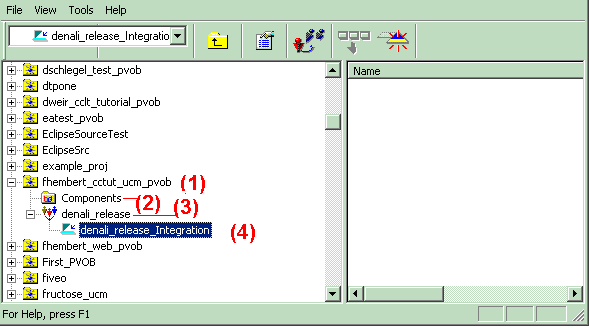Creating an Integration View
When you create a UCM project, HCL VersionVault creates the project's integration stream for you. An integration stream is a VersionVault UCM object that enables access to versions of the project's shared elements.
By default, a project contains only one integration stream, which maintains the project's baselines. The integration stream configures integration views to select the versions associated with the foundation baselines plus any activities and versions that have been delivered.
To see and make changes to the project's shared elements, you need an integration view. To create an integration view, follow these steps.
- In the Project Explorer, navigate to the integration stream by moving down the
object's hierarchy:
- Root folder (1)
- Project folder (2)
- Project (3)
- Stream (4)

- Select the integration stream and click to start the View Creation Wizard.
- In the View Creation Wizard, accept the default values to create an integration
view attached to the integration stream. By default, the View Creation Wizard uses this convention
for the integration view name: username_project-name_integration.
HCL VersionVault supports dynamic and snapshot views.
Dynamic views use the HCL VersionVault multiversion file system (MVFS) to provide immediate, transparent access to files and directories stored in VOBs. HCL VersionVault maps a dynamic view to a drive letter in Windows Explorer. We recommend that you make the integration view a dynamic view to ensure that you always see the correct version of files and directories that developers deliver to the integration stream.
Snapshot views copy files and directories from the VOB to a directory on your computer. When using snapshot views, you must perform an update operation to copy the latest delivered files and directories to your computer.
Follow the directions for the platform of interest to you: